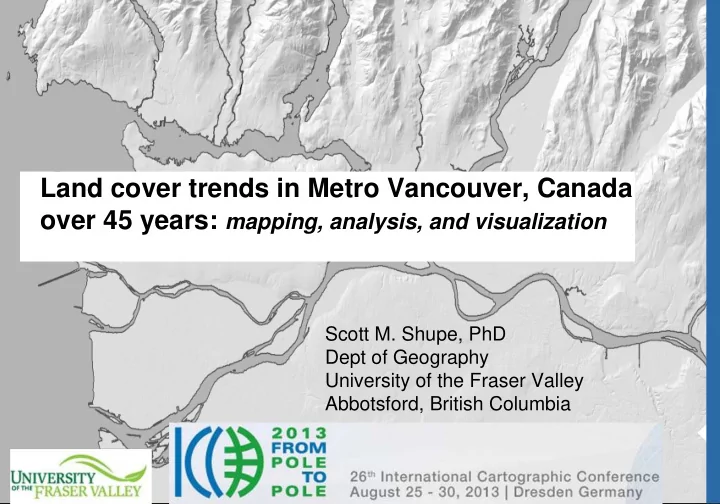

Land cover trends in Metro Vancouver, Canada over 45 years: mapping, analysis, and visualization Scott M. Shupe, PhD Dept of Geography University of the Fraser Valley Abbotsford, British Columbia
Land cover trends in Metro Vancouver, Canada over 45 years: mapping, analysis, and visualization Location and Context • Presentation Outline • Location and characteristics of area • Previous land cover mapping • Ongoing land cover mapping • Why land cover maps are needed and how they are used in research Credit: Scott Shupe 2
Land cover trends in Metro Vancouver, Canada over 45 years: mapping, analysis, and visualization Location and Context • In 45 years (1966 – 2011) population more than doubled (now > 2.3 million) - 52% English not mother tongue • Rapid urban expansion beyond city core - forested slopes of mountains - flatter agricultural plains • Urbanization impacts water quality, but: - cities are different ( urban observatory) - study characteristics of Vancouver LC on water quality over time Credit: Scott Shupe • Shupe (2013) – mapping LC on watershed basis from 1976 - 2000 3
Land cover trends in Metro Vancouver, Canada over 45 years: mapping, analysis, and visualization Location and Context • Shupe (2013) – mapping LC on watershed basis from 1976 – 2000. Related LC to historical water quality data Credit: Scott Shupe 4
Historical Watershed Level Analysis of Stream Water across Metro Vancouver Name of site Map of site? Highlight specific research points and/or impacts, areas of interest, pollution sources, etc. 5
Research Context Current and Future LC impact on water quality in Metro Vancouver • Working with Earthwatch Institute as part of a global 4 year Freshwater Research program funded by HSBC Bank • Training HSBC Bank Citizen Scientists to Collect basic water data which will be used with Landsat derived LC data in Vancouver • Contribute data and knowledge to the global Freshwater Research Program led by Steven Loiselle (Earthwatch, UK.) • HSBC Water Programme Key Cities 6
Research Context Interim map showing current CSL water quality monitoring sites 7
Research Context Why 45 years from 1966 – 2011? Goals • Expand the existing 1976 – 2000 land cover trend database - Use 1966 Canada Land Use Monitoring Program (CLUMP) data from the pioneering Canada Geographic Information System (CGIS). - In 2012 created a high quality 2011 Landsat LC data set to be used to back classify (or “improve”) old classifications and help forward classify future maps • Map and visualize trends in land cover change in additional parts of Metro Van • Highlight where sensitive ecosystems are being impacted 8
Land cover trends in Metro Vancouver, Canada over 45 years: mapping, analysis, and visualization Mapping Methods Mapping • Reconstruct historical CLUMP datasets (1966-86) • Create or modify more recent data sets (1993 – 2011) • Edit the digital maps to create consistent classes over the time period Analysis • Land change directions and amounts, particularly in watersheds • Spatial analysis of land cover and topography (with respect to water issues) Visualization • 2-D -> 3-D visualization from different angles to provide info to better understand LC changes 9
Mapping Methodologies Inconsistent, ambiguous, or missing data: 1966 Outdoor Recreation: Urban: Ambiguous Lack of detail 10
Mapping Methodologies Inconsistent, ambiguous, or missing data: 2006 • 2006 15 m data provided by government (via contractor) contains ambiguity Highly Reflective: Ambiguous 11
Mapping Methodologies Inconsistent, ambiguous, or historical data: mixed pixels always a problem Use spectral classification followed by geospatial data modeling and editing Simple 1986 example: 1)1986 CLUMP data that does not include detail of urban greenness 2)Classify urban structures in 1986 Landsat 3) Overlay 1) and 2) and maintain only common urban 12
Mapping Methodologies Backclassification • Can also “improve” 1976 CLUMP data using Landsat MSS imagery (but coarser 60 m resolution data) • 1966 CLUMP data is more problematic because no satellite data - assume that urbanization is linear and can thus we can “grow” missing green areas in urban areas in 1966 map based upon 1976 data. 13
Mapping Methodologies Good reference data essential: leveraging high resolution imagery backdrop in GIS 2011 Landsat Classification: 1)Unsupervised classification 2)Model with Tasseled Cap greenness & other derivatives 3) Edit using Bing imagery 14
Mapping Methodologies Good reference data essential: leveraging high resolution imagery 2011 Landsat urban classification overlay on Bing imagery in GIS Use of available high resolution imagery: - accuracy assessment - updating 2011 map - then update older maps where possible e.g. remove urban in 2000 not present in 2011 Caveat: need to be aware of date of base layer imagery and how licensing agreements may affect image availability 15
Analysis and Visualization We need to monitor changes in LC with changes in water quality over time: 2000 snapshot of urbanization in selected watersheds 16
Analysis and Visualization We need to monitor changes in LC with changes in water quality over time: 45 years of urban increase at expense of forest and agriculture 17
Analysis and Visualization We need to monitor changes in LC with changes in water quality over time: 45 years of urban increase at expense of forest and agriculture 18
Analysis and Visualization Metro Vancouver is undergoing continuous urbanization and land cover change 19
Analysis and Visualization Metro Vancouver is undergoing continuous urbanization and land cover change 2011 Urban Surface 1966 Urban Surface 20
Summary Metro Vancouver is undergoing continuous urbanization and land cover change Land cover maps over a 45 year period provide essential data that can be related to water quality data from sampling programs Satellite data essential to land cover mapping Relatively simple mapping methods: most complexity related to creating consistent land cover classes over time. Current plans are to map Vancouver land cover for 2013 using new Landsat 8 data and update land cover maps into the future using change mapping techniques. Acknowledgement: Robert Auffray’s time editing land cover maps in a GIS! 21
Recommend
More recommend